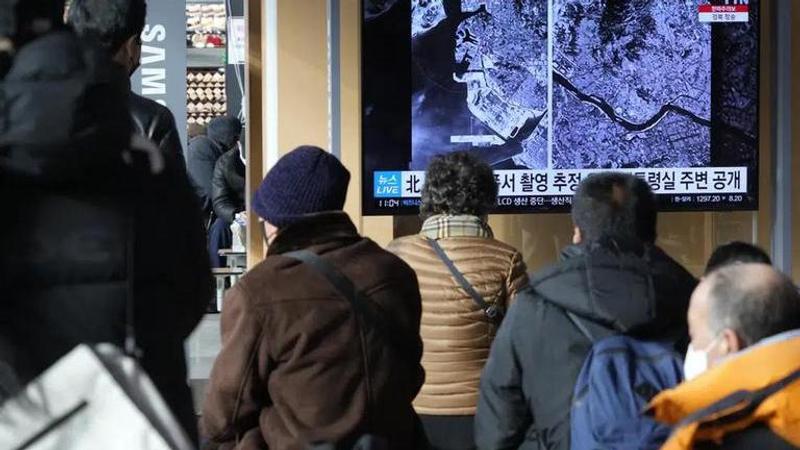Published 11:59 IST, December 19th 2022
North Korea says latest launches tested first spy satellite
North Korea said Monday it fired a test satellite in an important final-stage test for the development of its first spy satellite.

North Korea said Monday it fired a test satellite in an important final-stage test for the development of its first spy satellite, a key military capability coveted by its leader Kim Jong Un along with other high-tech weapons systems.
The North’s official Korean Central News Agency also released low-resolution, black-and-white photos showing a space view of the South Korean capital and Incheon, a city just west of Seoul, in an apparent attempt to show the North is pushing to acquire a surveillance tool to monitor its rival.
The rocket carrying the test satellite was launched Sunday to assess the satellite’s photography and data transmission systems, KCNA said.
The country’s National Aerospace Development Administration called the test results “an important success which has gone through the final gateway process of the launch of reconnaissance satellite.” It said it would complete the preparations for its first military reconnaissance satellite by April next year, according to KCNA.
“From the images released, the resolution does not appear to be so impressive for military reconnaissance,” Soo Kim, a security analyst at the California-based RAND Corporation, said. “I’d note, however, that this is probably an ongoing development, so we may see more improvements to North Korea’s military reconnaissance capabilities over time.”
South Korea, Japan and U.S. authorities said Sunday they had detected a pair of ballistic missile launches by North Korea from its northwestern Tongchang-ri area, where the North’s satellite launch pad is located. They said the two missiles flew about 500 kilometers (310 miles) at a maximum altitude of 550 kilometers (340 miles) before landing in the waters between the Korean Peninsula and Japan.
This meant North Korea likely fired two missiles with different types of cameras — one for black-and-white imagery and video and the other for color, given the North’s state media said that Sunday’s test involved both types of cameras, said Lee Choon Geun, an honorary research fellow at South Korea’s Science and Technology Policy Institute.
An analysis of a photo of the launch also showed the missiles were likely a new type of a liquid-fueled weapon that can be used for a military purpose as well as sending a satellite into orbit, Lee said.
Geon Ha Gyu, a spokesperson for South Korea’s Defense Ministry, told reporters Monday that the South Korean and U.S. assessments that North Korea fired the two medium-range ballistic missiles remain unchanged. He said South Korean and U.S. intelligence authorities were analyzing further details of the launches but declined to elaborate.
A spy satellite was on a wish list of sophisticated military assets Kim announced during a ruling party meeting early last year, together with multi-warhead missiles, solid-fueled long-range missiles, underwater-launched nuclear missiles and nuclear-powered submarines. Kim has called for such modern weapons systems and an expanded nuclear arsenal to pressure the United States to abandon its hostile polices on North Korea, an apparent reference to U.S.-led sanctions and the U.S.-South Korean military drills that North Korea views as an invasion rehearsal.
North Korea has since taken steps to develop such weapons systems. In February and March, North Korea said it conducted tests to check a camera and data transmission systems to be used on a spy satellite. In November, it test-launched its developmental, longest-range Hwasong-17 intercontinental ballistic missile, a weapon believed to be designed to carry multiple warheads. Last week, North Korea said it performed a “high-thrust solid-fuel motor” to be used for a new strategic weapon, an apparent reference to a solid-fueled ICBM.
Ankit Panda, an expert with the Carnegie Endowment for International Peace, said that North Korea will likely make a proper orbital launch for a reconnaissance satellite probably around April 15, the birthday of Kim’s late grandfather and state founder Kim Il Sung. The day is one of the most important state anniversaries in North Korea.
North Korea has previously put what it called Earth observation satellites into orbit in 2012 and 2016. Many foreign experts say both satellites were tasked with spying on its rivals though there has been no evidence that either satellite has ever relayed any imagery back to North Korea.
According to North Korea’s state media, one of the cameras tested Sunday has a 20-meter (65-feet) resolution, which Lee, the expert, said can only recognize relatively big targets such as warships sailing on the ocean and military installations in South Korea.
Lee said North Korea may be able to covertly get a more advanced camera that enable it to monitor tanks and the deployment of U.S. strategic assets to South Korea. He said such a camera would greatly boost North Korea’s surveillance capability.
Earlier this year, North Korea test-launched a record number of missiles, many of them nuclear-capable missiles with varying ranges to reach the U.S. mainland and its allies South Korea and Japan. It also legislated a law authorizing the preemptive use of nuclear weapons on a broad range of scenarios, causing security jitters in South Korea and elsewhere.
North Korea has avoided fresh U.N. sanctions for those moves, however, because U.N. Security Council permanent members Russia and China won’t support U.S. attempts to impose them.
“Having codified his country’s nuclear law earlier this year, tested missiles of varying capabilities, and made it very clear he has no interest in diplomacy with the U.S. and South Korea, Kim has essentially paved the way for nuclearization,” Soo Kim, the analyst, said. “He’s lent the appearance that the only possible way out of this quagmire is for the international community to fold the conditions set forth by the regime.”
She said a handful of other high-priority geopolitical concerns involving China and Russia “has allowed Kim to buy time and the grace of the international community to push forward with his plan.”
Updated 11:59 IST, December 19th 2022




